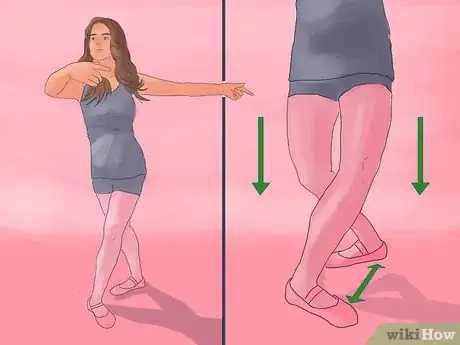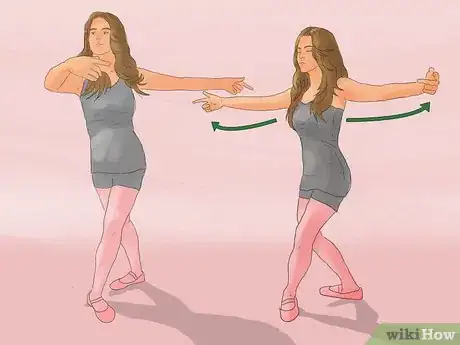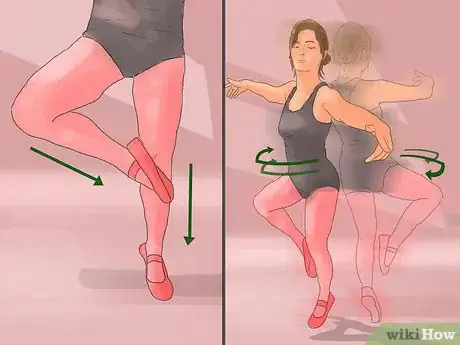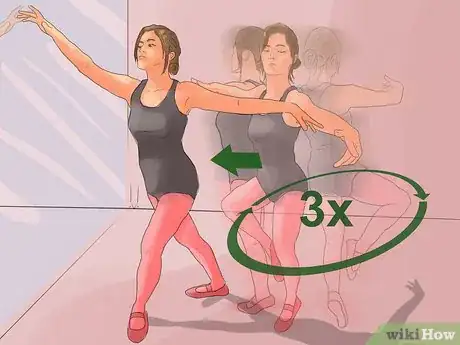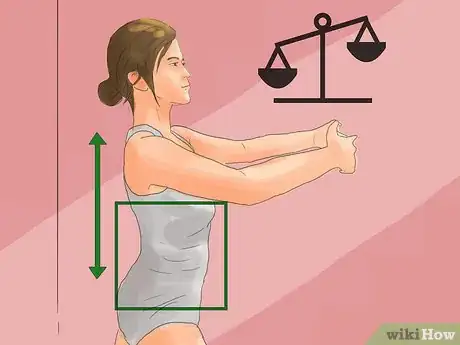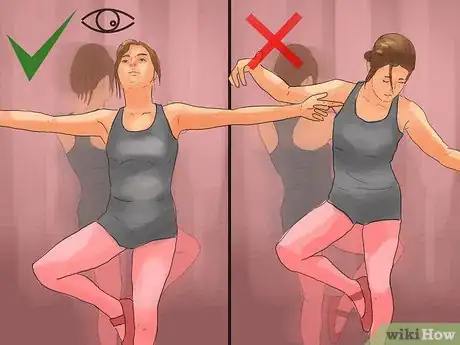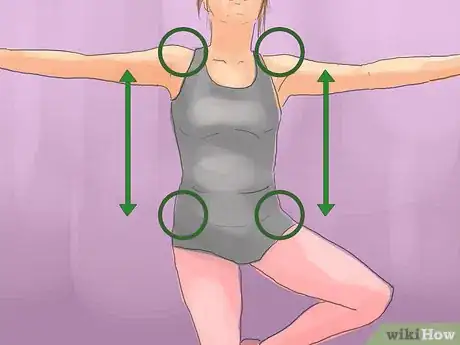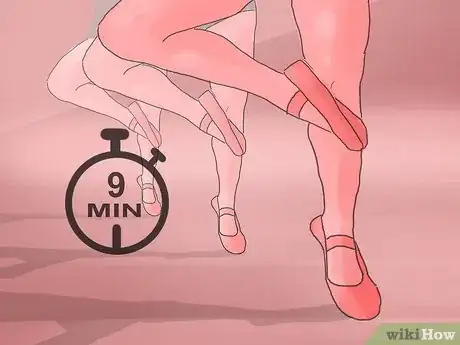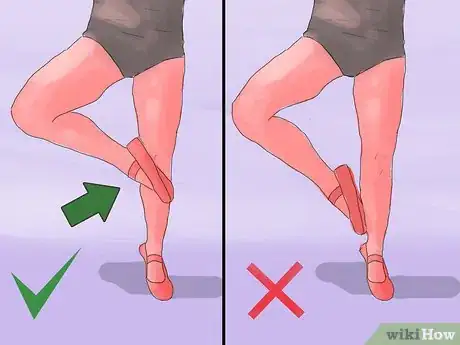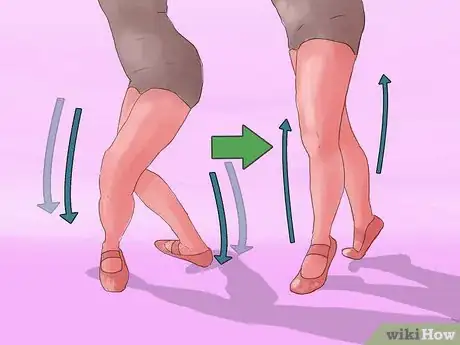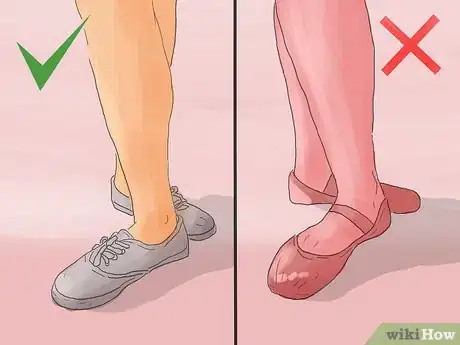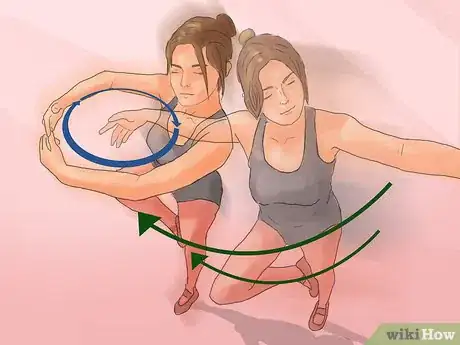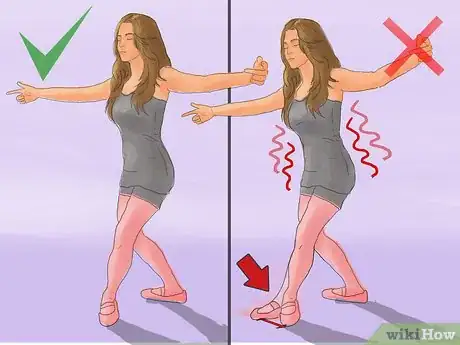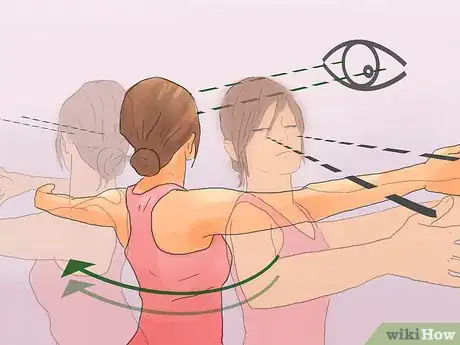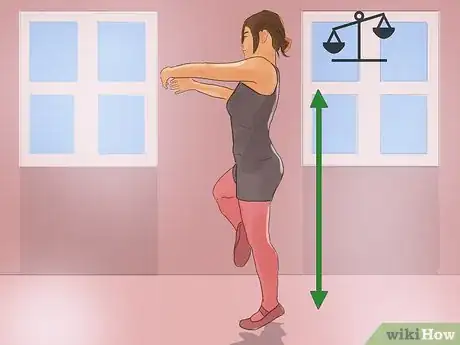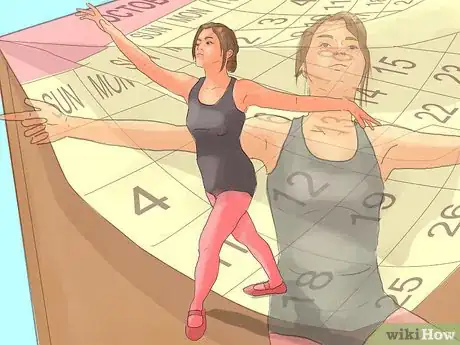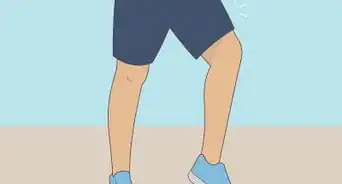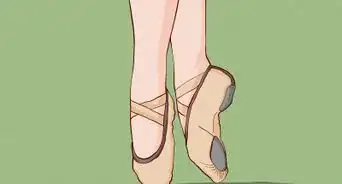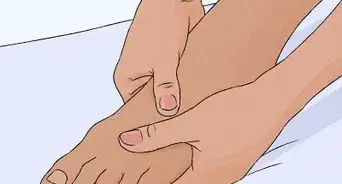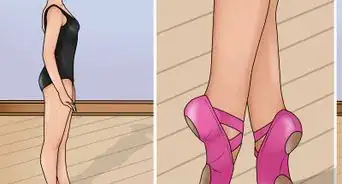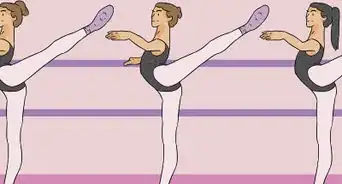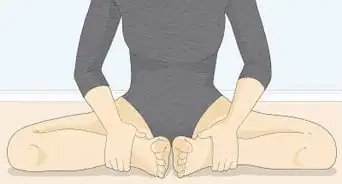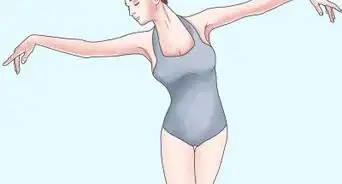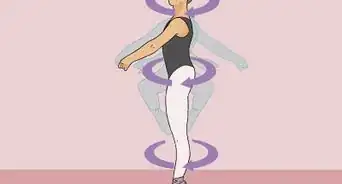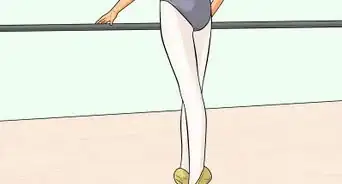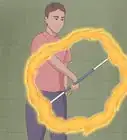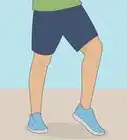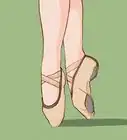This article was co-authored by Geraldine Grace Johns. Geraldine Grace Johns is a Professional Ballerina and the Owner of Grace Ballet in New York and Los Angeles. Geraldine toured through New Zealand, Australia, Japan, and Korea as Jammes in Ken Hill's Original Phantom of the Opera. She has studied with the Royal Academy of Dance in London to become a teacher and taught for the Kudo School of Ballet in Yokohama. Geraldine also ran her own Royal Academy of Dance School in New Zealand before studying at the Neighborhood Playhouse School of the Theatre in New York City. Geraldine was a guest coach and Master Class teacher in Toronto for the Canadian Royal Academy of Dance's Dance Challenge in 2018, 2019, and 2020. She was also a guest coach and Master Class teacher for the USA Royal Academy of Dance Challenge in Long Beach, California in 2019 and 2020. Grace Ballet Los Angeles has won recognition as one of 13 Best Ballet Schools in Los Angeles since opening her school. Geraldine is a contract Practical Teaching Supervisor for the Certificate in Ballet Teaching Studies for the Royal Academy of Dance.
This article has been viewed 45,567 times.
Pirouettes are a fun and beautiful movement that can be used in dance, sports, or just for fun. While they may seem delicate and are commonly associated with the grace of ballet, you must learn how to initiate your muscles for proper coordination to achieve a fluid motion. Focus on the fundamentals of a pirouette before trying to initiate multiple turns. Practice and visualize the movements to complete a triple pirouette.
Steps
Focusing on Pirouette Fundamentals
-
1Start with a plié.[1] A plié refers to a stance in which you bend your knees outward while keeping your legs straight. Bend both legs so that you are almost at a deep lunge. Lift the back heel off the ground to prepare to initiate your movement into the turn.[2]
- Stand with feet flat on the floor without bearing weight on either the inside or the outside of our foot. Make sure your weight is centered over the ball of your foot so as not to disrupt your alignment. Work on the angle between your feet as it will depend on the natural rotation of your hips. Once your feet are positioned, align your knees between your second and third toes and initiate the movement.
-
2Open your arms. Your arms will give you momentum to complete the turn. As you initiate your turn you want to close your arms into a circle as if you are holding a round beach ball. They should be straight out in front of your chest with your hands facing with palms inward and thumbs aligned.[3]Advertisement
-
3Lift your back leg and initiate your turn. As you lift your back leg place your foot above the knee of your straight leg with your toe pointed toward the ground and turn. The one legged stance is known as relevé. Remember to keep your back straight and arms in a circle in front of you as you turn.[4]
-
4
-
5
Executing Multiple Pirouettes
-
1Pull up and keep your core engaged. Your core should be completely engaged to complete each pirouette. Focus on having proper balance and correct alignment. Picture being pulled up from the top of your head by an invisible string to a high relevé.
- Strengthen your core with exercises like yoga, pilates, ballet, and jazz dance.
-
2Spot quickly. Spotting is exactly as it sounds as you turn your head and spot a point to turn your head in the direction you want to pirouette in.[9] In order to achieve neat, quick turns your head must follow suit with a sharp, quick head turn. Spot a point slightly above your eye line, which will lift your chin as you turn.
- If you look at the floor you will fall. Your pirouette will follow your line of sight as it helps you keep your balance.
-
3Keep proper alignment. Your hips should be aligned with your shoulders as you complete each pirouette. Your balance will be off as you turn if your alignment is off. Use a mirror as you stand in relevé to ensure that your shoulders and hips are aligned.
- Check your side stance as well when you are at the mirror to ensure that you’re not leaning too far forward or back.
-
4Keep your balance on relevé. The base of each pirouette will be balanced on relevé so focus on keeping this balance without turning. You should be able to balance on relevé for several seconds otherwise you won’t be able to stay up during your pirouettes. Build your strength by balancing on each leg for 8 seconds or more. Try to balance as long as you can each time you practice.
- Practice different turns to improve your balance such as turned-out retire, non-turned-out jazz pirouette, and turns in a la seconde. Changing up your turns will improve your balance.
- Compete with your friends to make practicing more fun. See who can hold their balance the longest.
-
5Position your toe correctly when you retire. Retire is a pose in ballet where your raise one leg to the side and bend the knee of that leg so that your toe points to make the sole of your foot parallel to the knee of your other leg. Your toe on your raised leg should be glued to the knee of your straight leg. If your toe drops below your knee as you pirouette, your turn will also drop. Your toe will pull your weight down so keep it level to your knee with your toe pointed. Not pointing your toe looks sloppy and ruins your form.
-
6Use the floor. Give each pirouette energy by pushing off the floor from a deep plié position. Imagine that you are a spring so that you are ready to bounce up when pushed down. Give each pirouette momentum as you push yourself up from the ground. Control your force as you don’t want to push with too much energy that it throws off your coordination.
- You want a deep plié for a powerful turn. Try breathing out as you plié to increase your power.
-
7Wear appropriate footwear.[10] Make sure to wear proper footwear as it is difficult to execute multiple pirouettes barefoot because your feet will stick to the floor. You may also get a painful burn. There are special dance shoes designed specifically for pirouettes that you can purchase online or at your local dance store. These shoes enhance your natural arch will provide the traction needed to turn efficiently.
-
8Pull in your arms for tighter turns. Keep the energy close to your body by crossing your palms over each other and keeping your arms close in a tight and neat circle. Make sure that your arms are connected to your back and shoulder blades by pretending that there is a rod that keeps your shoulder blades and upper back wide and open.
- If your arms open from a tight and neat circle the energy and weight will be dispersed and through off your coordination.
Troubleshooting Pirouette
-
1Focus on coordination. Do not turn your supporting foot before you initiate the turn by allowing your other foot to take off.Your hip and shoulder will open too early and your arms will lag behind. Push off your back toes to initiate the turn and keep your leg turned in. Keep your core in one piece as you use your arms as a steering while to guide your core around the turn.
- You know your coordination is off if you feel out of control or like you are in the spin cycle of your washing machine.
-
2Determine where you’re spotting. Spot before you turn and do not change it. Changing your spot as you turn will throw you off. If you spot too slowly or too fast your rotation will suffer. Think of the music when you need to spot; then, spot, hold, and follow through.
-
3Keep your balance. Poor alignment can come from sitting on your supporting side, lifting your working hip, or throwing your upper body back. Think about squaring your hips and shoulders, keeping your core engaged, and keeping your legs strong under you. Push down on your supporting leg as you lift the other to follow through in your turn under balance.
-
4Practice as much as your schedule allows. Practice fundamentals and technique. Don’t develop bad habits. Focus on every movement and the correct function of each part of your body. Use a mirror to help with form. Practice with friends to help support each other.
- Avoid changing your focal mid spot or spotting too slowly. This will throw off your coordination and balance. Make sure you keep your core engaged and keep your body in a straight line. It’s easy to fall into the bad habit of tilting or slouching if you don’t focus on keeping your body pulled up.
Expert Q&A
Did you know you can get expert answers for this article?
Unlock expert answers by supporting wikiHow
-
QuestionWhy do I keep falling out of my pirouettes?
 Geraldine Grace JohnsGeraldine Grace Johns is a Professional Ballerina and the Owner of Grace Ballet in New York and Los Angeles. Geraldine toured through New Zealand, Australia, Japan, and Korea as Jammes in Ken Hill's Original Phantom of the Opera. She has studied with the Royal Academy of Dance in London to become a teacher and taught for the Kudo School of Ballet in Yokohama. Geraldine also ran her own Royal Academy of Dance School in New Zealand before studying at the Neighborhood Playhouse School of the Theatre in New York City. Geraldine was a guest coach and Master Class teacher in Toronto for the Canadian Royal Academy of Dance's Dance Challenge in 2018, 2019, and 2020. She was also a guest coach and Master Class teacher for the USA Royal Academy of Dance Challenge in Long Beach, California in 2019 and 2020. Grace Ballet Los Angeles has won recognition as one of 13 Best Ballet Schools in Los Angeles since opening her school. Geraldine is a contract Practical Teaching Supervisor for the Certificate in Ballet Teaching Studies for the Royal Academy of Dance.
Geraldine Grace JohnsGeraldine Grace Johns is a Professional Ballerina and the Owner of Grace Ballet in New York and Los Angeles. Geraldine toured through New Zealand, Australia, Japan, and Korea as Jammes in Ken Hill's Original Phantom of the Opera. She has studied with the Royal Academy of Dance in London to become a teacher and taught for the Kudo School of Ballet in Yokohama. Geraldine also ran her own Royal Academy of Dance School in New Zealand before studying at the Neighborhood Playhouse School of the Theatre in New York City. Geraldine was a guest coach and Master Class teacher in Toronto for the Canadian Royal Academy of Dance's Dance Challenge in 2018, 2019, and 2020. She was also a guest coach and Master Class teacher for the USA Royal Academy of Dance Challenge in Long Beach, California in 2019 and 2020. Grace Ballet Los Angeles has won recognition as one of 13 Best Ballet Schools in Los Angeles since opening her school. Geraldine is a contract Practical Teaching Supervisor for the Certificate in Ballet Teaching Studies for the Royal Academy of Dance.
Professional Ballerina & Ballet Instructor
-
QuestionHow can I stop hopping on my turns?
 Community AnswerI was always told to push into the floor through the ball of my foot and pull up through my spine. By maintaining proper alignment and practicing consistently, you will eventually be able to do clean triples easily. I was taught that falling over out of a turn was better than hopping, and that helped me.
Community AnswerI was always told to push into the floor through the ball of my foot and pull up through my spine. By maintaining proper alignment and practicing consistently, you will eventually be able to do clean triples easily. I was taught that falling over out of a turn was better than hopping, and that helped me. -
QuestionI have practiced, but I never seem to be able to turn more than once. How can I keep turning?
 Community Answerif you have long hair, you should put it in a bun to prevent it from hitting your face or throwing you off-center. Make sure you're prepping your turn correctly and giving yourself enough momentum to make it around more than once. Use the correct form and remember to spot.
Community Answerif you have long hair, you should put it in a bun to prevent it from hitting your face or throwing you off-center. Make sure you're prepping your turn correctly and giving yourself enough momentum to make it around more than once. Use the correct form and remember to spot.
Warnings
- Keep your turns under control. You may injury yourself or others if you use too much energy and momentum that causes you to spin out of control.⧼thumbs_response⧽
- Don't practice in small places. Make sure you have have enough space so that you don’t hurt anybody or hurt yourself.⧼thumbs_response⧽
- Don't attempt to pirouette on rugs as it will stifle your movements and you can injure yourself.⧼thumbs_response⧽
References
- ↑ Geraldine Grace Johns. Professional Ballerina & Ballet Instructor. Expert Interview. 11 November 2020.
- ↑ https://snapguide.com/guides/do-a-jazz-pirouette/
- ↑ https://snapguide.com/guides/do-a-jazz-pirouette/
- ↑ https://snapguide.com/guides/do-a-jazz-pirouette/
- ↑ Geraldine Grace Johns. Professional Ballerina & Ballet Instructor. Expert Interview. 11 November 2020.
- ↑ https://snapguide.com/guides/do-a-jazz-pirouette/
- ↑ Geraldine Grace Johns. Professional Ballerina & Ballet Instructor. Expert Interview. 11 November 2020.
- ↑ https://snapguide.com/guides/do-a-jazz-pirouette/
- ↑ Geraldine Grace Johns. Professional Ballerina & Ballet Instructor. Expert Interview. 11 November 2020.
- ↑ Geraldine Grace Johns. Professional Ballerina & Ballet Instructor. Expert Interview. 11 November 2020.
